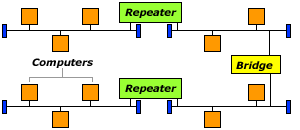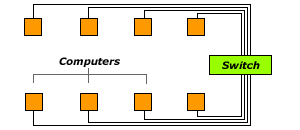Ethernet cards or network interface cards are commonly supplied with all newly manufactured PC’s and are the interface between the computer and the transmission medium or cable.
 The Ethernet card controls the data being transmitted and received from the computer, Some of its many functions include fragmenting the data into manageable chunks called frames, to prepare it for transmission and to reassemble the received frames upon arrival. The card holds a unique address so that computers can locate each other on the network. Data carried on an Ethernet network conforms to a protocol called Carrier Sense Multiple Access with Collision Detection (CSMA/CD).
The Ethernet card controls the data being transmitted and received from the computer, Some of its many functions include fragmenting the data into manageable chunks called frames, to prepare it for transmission and to reassemble the received frames upon arrival. The card holds a unique address so that computers can locate each other on the network. Data carried on an Ethernet network conforms to a protocol called Carrier Sense Multiple Access with Collision Detection (CSMA/CD).
Older Ethernet networks would conform to a standard known as 10 Base 5 – which consisted of a half inch 50 -ohm coaxial cable sometimes referred to as ‘thick’ Ethernet. The 10 indicated the 10Mbps data transfer rate, Base refers to the Baseband transmission mode and 2 indicates a 185 (rounded to 200) metre recommended bus segment length or cable run.
It was possible to add additional length to an Ethernet bus, simply by adding a device called a repeater, which amplifies the signal, allowing the it to reach greater distances and prevent attenuation or weakening. Also, separate networks could be linked together by connecting a device called a Bridge. A Bridge would hold a small database of computers and their corresponding addresses, which after examination of the frame would determine whether or not the data is transmitted onto the linked network or stay on the source network.
There were many problems with this older style network configuration, mainly because each computer on the network had to contend with every other computer to send its data, as a result many collisions would occur and the network would become extremely slow.
 Today, most Ethernet installations conform to a standard known as 100/1000 Base T. The numbers refer to the maximum data transfer rate – 100 Mbps or 1000Mbps (1 Gbps). The Base is the Baseband signal and T refers to the Twisted pair medium or wire that carries the data.
Today, most Ethernet installations conform to a standard known as 100/1000 Base T. The numbers refer to the maximum data transfer rate – 100 Mbps or 1000Mbps (1 Gbps). The Base is the Baseband signal and T refers to the Twisted pair medium or wire that carries the data.
When using twisted pair cabling, a star topology is commonly used. Instead of each computer having to contend with other devices to send its signal, each computer can have a direct connection with a device called a switch (smaller networks may use a hub) which creates a virtual circuit with the destination device.
In the above configuration each each computer can potentially achieve its maximum data rate of 100 or 1000 Mbps.

